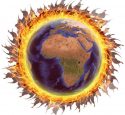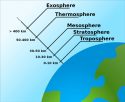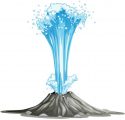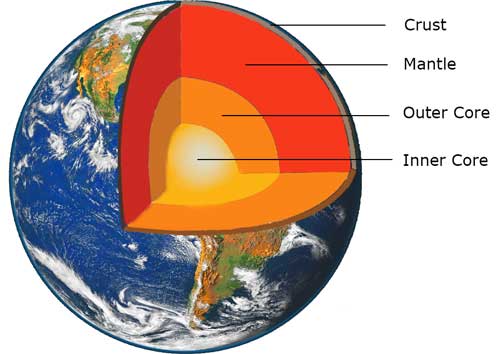 The Earth is a very dynamic terrestrial planet that is composed of complex structures and layers. The chemical composition and the layers of the Earth play a crucial role in giving it the geological and atmospheric properties that we have today. Furthermore, the core of the Earth that is at its center gives a powerful magnetic field that protects us from the Sun.
The Earth is a very dynamic terrestrial planet that is composed of complex structures and layers. The chemical composition and the layers of the Earth play a crucial role in giving it the geological and atmospheric properties that we have today. Furthermore, the core of the Earth that is at its center gives a powerful magnetic field that protects us from the Sun.
Layers of the Earth
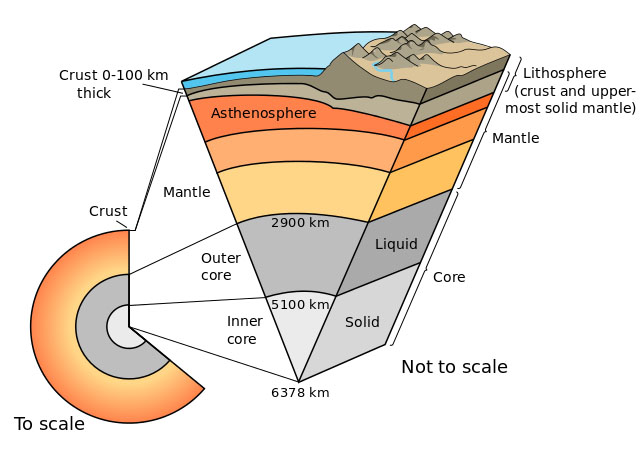
Our Earth is not a solid piece of rock, like an iron ball. Instead, it is made up of several layers. Each layer has its own physical and chemical properties. Each layer plays an important in making the Earth look like as we know it today.
Our Earth is divided into four main layers, each layer having unique physical properties. These layers are Crust, Mantle, Outer core, and Inner core. Let’s dig into these layers and find out what they are made of.
The Crust
The crust is the topmost layer of the Earth on which you stand. All the mountains, jungles, and oceans you know are held on this layer. It is the thinnest layer among the four layers. This layer is 70 Km thick on the land, and 5 Km thick at some points on the ocean floor. The crust is not a one-piece solid layer, but it is divided into tectonic plates. Most of the geological activities, such as earthquakes, continental drifting, and volcanic activity, are witnessed here. The crust is mostly composed of silica, alumina, lime, magnesia, and iron oxide (rust).
Element-wise, the crust is 99% made up of below-mentioned elements.
- Oxygen (O) – 46.6%
- Silicon (Si) – 27.7%
- Aluminum (Al) – 8.1%
- Iron (Fe) – 5.0%
- Calcium (Ca) – 3.6%
- Sodium (Na) – 2.8%
- Potassium (K) – 2.6%
- Magnesium (Mg) – 2.1%
The Mantle
The Mantle starts below the crust and is denser than the crust. It is 3,000 Km in thickness and is mostly made of silicate rocks rich in magnesium and iron. This layer is not perfectly solid. At some locations, the rock is completely melted, which is called magma. When this magma reaches near the crust, it erupts as Lava from the volcanoes.
In this layer, rocks are in constant motion of rising and sinking due to internal heat from the core. This rising and sinking of the molten rocks set up the convective currents. These convective currents also cause the tectonic plates to move and crash into each other causing earthquakes.
The Outer Core
This layer of the Earth is in the liquid state at a temperature of 5,000 °C. This layer is mostly made of iron and nickel. Both of these metals are in a liquid state due to intense heat. The outer core is always in constant motion due to convective currents. These convective currents are formed due to constant heating from the solid inner core and cooling at the mantle boundary.
The convective current in the outer core also creates a strong magnetic field around the Earth. This magnetic field protects our Earth from the Sun’s deadly wind. Without this layer, our Earth couldn’t have a magnetic field. Without this magnetic field, our Earth could never have an atmosphere, oceans, and life. The outer is not directly accessible for study due to its extreme depth. Scientists study the outer core by observing seismic activity and changes in the Earth’s magnetic field.
The Inner Core
The inner core is the hottest layer of the Earth, reaching a temperature of 7,000 °C; much hotter than the surface of the Sun. It is also composed of iron and nickel metal. The inner core is in solid form despite having such a high temperature. This is because the inner core is under tremendous pressure due to the weight of the other layers. Moreover, the inner solid core is the also main source of heat for other layers. The heat energy at the center of the Earth is the result of the radioactive decay of heavy elements and residual heat from the formation of the Earth.
Facts
- Earth is the only planet, where life is found.
- It is the third planet from the Sun.
- It has only one moon, called Luna.


